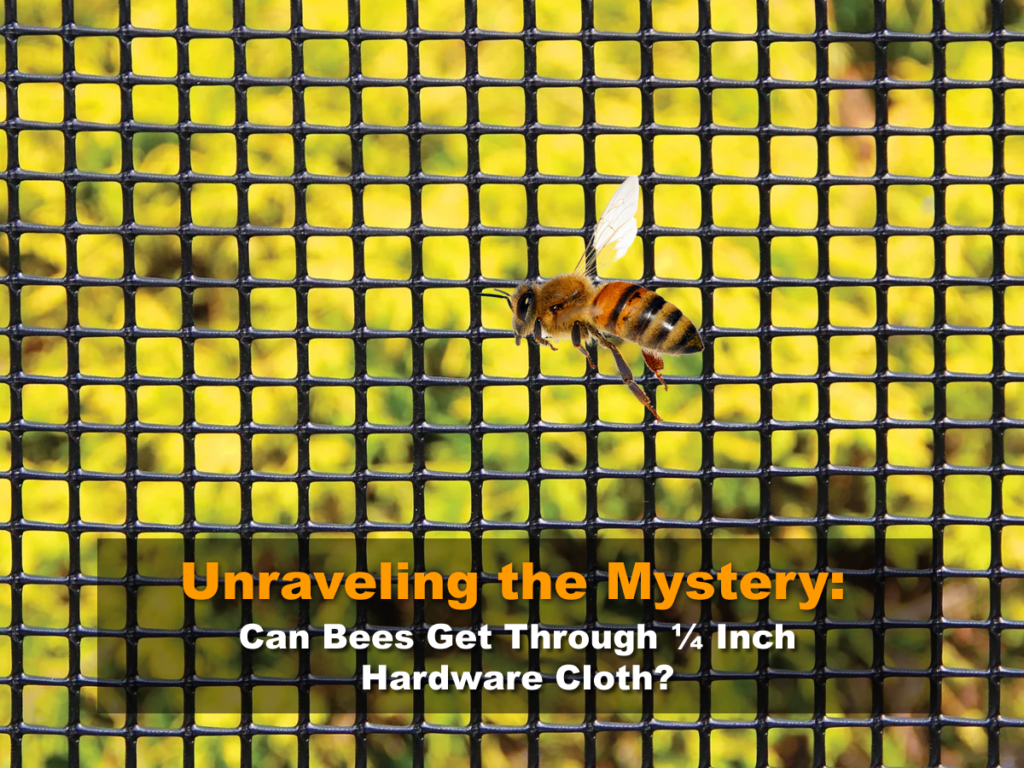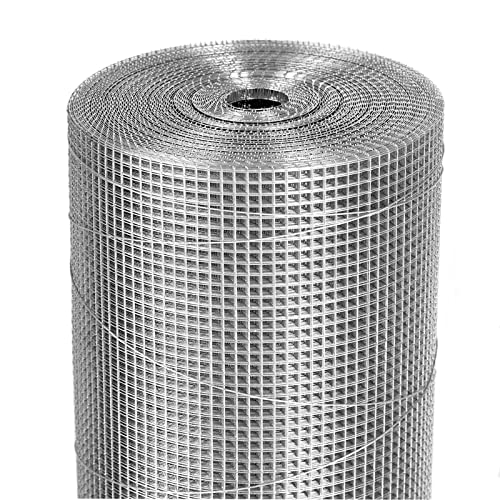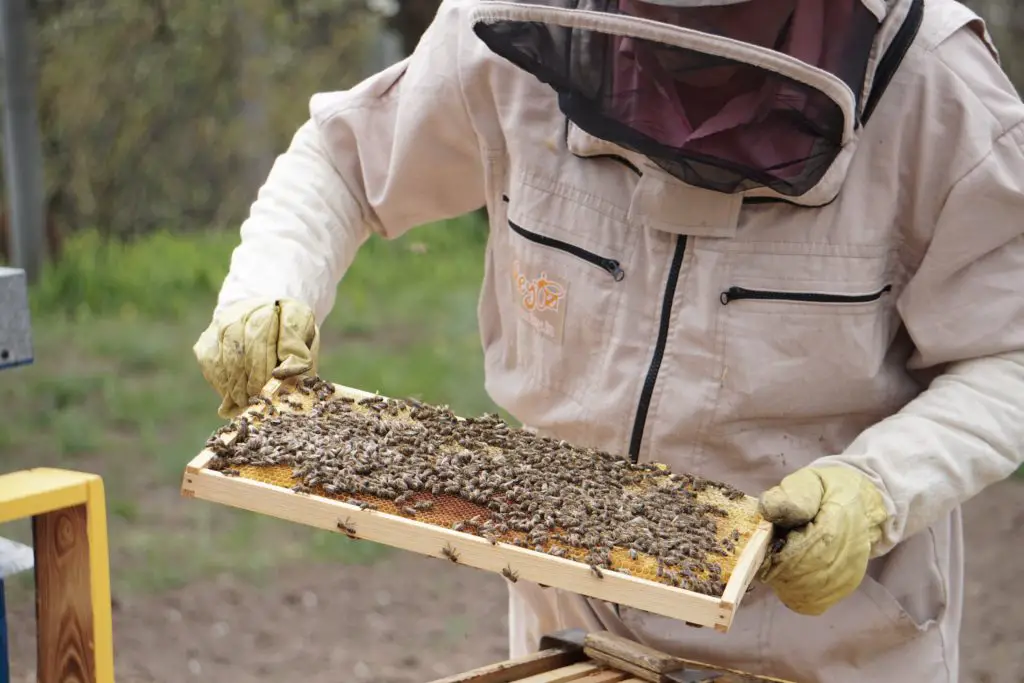Affiliate Disclaimer - As an Amazon Associate I earn from qualifying purchases.
It supports the website. So, Thank you
I’ve probably said it a million times, and I’ll say it a million times more; I love bees! I love them so much that I couldn’t stand the thought that anything I did in my garden was causing them harm or making life more difficult for them.
However, I’m also a keen gardener and I have been pretty sick and tired of pests accessing my plants. If it isn’t slugs and snails nibbling on my leaves, it’s rabbits taking a bite out of my strawberry plants. The problem I had was that I needed a way to prevent pests from attacking my plants without restricting the bees’ access to them.
I decided that the best method would be to use hardware cloth. But once I started shopping, one of the first things I noticed was that there are so many different sizes. I thought that the ¼ inch option looked pretty viable but first I needed to investigate whether this would be suitable for bees and I asked myself can bees get through ¼ inch hardware cloth?
¼ inch hardware cloth is an ideal option for bees. The squares are small enough that pests won’t be able to get through but the holes are just about right for most bees.
Before I made any purchases, I decided that I wanted to look a little further into the matter. In this post, I’ll share what I found with you.
Table of Contents
Understanding Hardware Cloth Sizes
Before I start talking about the right-sized hardware cloth for bees, I’d like to dive into the various sizes. If you’ve never shopped for hardware cloth before then you might find this a little confusing and it’s no wonder as there are many sizes to choose from.
In North America, you’ll notice that hardware cloth is sold according to a numbered system. This system tells you how many squares fit into one inch. For example, if you choose #4 hardware cloth, this will have four squares per inch. #8 Hardware cloth will have eight squares per inch, and so on. It’s important to keep in mind that this refers to a linear inch and not a square inch.
What Is Hardware Cloth Used For?
Hardware cloth is made from interlaced lengths of metal fabric and the result is a type of woven mesh. It’s a common material that has a wide range of uses including filters, fences, cages, and much more.
However, not all types of hardware cloth are the same. The main differences between these types are to do with the wire gauge and type. Other factors that set one type apart from another are the finish of the metal and how the wires are woven together. There are a number of different techniques used for this but that’s not for this post.
The great thing about hardware cloth is that it’s an incredibly flexible material which is why it’s so adaptable to its various applications. When a manufacturer creates hardware cloth, they will alter the production depending on the intended use of the product. This might include the way the hardware cloth is constructed, the type of wire used and the overall style of the finished product.
One of the main things that determine the best application for any given piece of hardware cloth is the metal that is used. However, you might often see it being used in construction, architecture and even in food production.
For as far back as many of us can remember, the material of choice for enclosing animals and plants was chicken wire. While this is a fantastic material, one of its drawbacks is that it’s so easy to break or cut through. Because of this, agriculture workers and domestic gardeners started using hardware cloth as an alternative.
The benefit of this was that it was a much stronger and more durable option because of how dense it is compared to chicken wire. It is far more difficult to cut through and, unlike chicken wire, it doesn’t lose its shape over time.
Why Are Some Hardware Cloths Unsuitable For Bees?
Not all hardware cloth is made equal and, as we have seen by now, this material comes in a range of different sizes. It is for this reason that not all hardware cloth is suitable for use in the backyard where you’re looking to keep bees in or out of a particular area.
Buy hardware cloth that is too small and pollinating bees will struggle to get through, especially when their pollen baskets are loaded up. What’s more, I’ve heard many beekeepers talking about the fatal results of their bees getting stuck in the gaps. That’s the last thing we want when we’re actually trying to help these little guys.
On the other hand, if you’re looking to keep bees away from your plants and deter them from your garden then using hardware cloth whose holes are too big isn’t going to be effective.
It’s worth considering what you’re trying to achieve by using the hardware cloth before you start. I’d also suggest looking at the size of bees in your local area. If you’re a beekeeper then this will be much easier as you’ll just look at the size of the bees in your colony. Otherwise, spend some time observing what species are more common as this will help you to make a better choice.
What Is The Best Size Of Hardware Cloth For Bees?
When it comes to choosing the right size hardware cloth for use with bees, there’s no set rule to follow. The reason for this is that there are so many variations which is why I suggest taking your own circumstances into consideration.
Bees come in a massive range of sizes and this all comes down to their species and genetics. So, it would be impossible to say which was the ultimate size.
Moreover, you have to consider that different hardware cloth manufacturers might make their products to different standards. For example, you may buy a #4 hardware cloth from one manufacturer and find that the holes are slightly smaller than another manufacturer because of the thickness of the wire.
However, if you want to keep bees out of your garden then I would seriously consider going for hardware cloth whose holes are no bigger than ⅛ inch or 3 mm as there aren’t any species of bees that are able to get through this size.
With that in mind, it is worth noting that if the hardware cloth is not properly installed or if there are any gaps between sheets then this acts as an entrance point for bees. So, when installing your hardware cloth, make sure to double-check that it is secure all over.
At the beginning of this post, I asked whether bees can get through ¼ inch hardware cloth. Most bees will be able to get through the holes in this size so it’s ideal if you’re looking to keep pests out but still want bees to have access to the flowers.
Recommended ¼ Inch Hardware Cloth
The Use Of Hardware Cloth According To Size In Beekeeping
The information above is really useful if you’re a gardener looking to keep bees in or out of a particular area. However, if you’re into beekeeping then you’ll find a whole host of other uses for hardware cloth. How the material is used largely depends on the size so I’d like to provide you with some information on what you can use each size for.
- #2 Hardware cloth is often used at the bottom of the hard candy feeder.
- #3 Hardware cloth is a common choice for beekeepers when crafting a mouse guard. However, the size is still big enough for the honey bees to pass through.
- #5 Hardware cloth can be used but it’s worth keeping in mind that the holes can be quite small which is OK for worker bees but not such good news for the larger drones. Moreover, a queen would never get through these gaps which is why #5 is often used when making a queen excluder. Of course, when you restrict the queen, the behavior of the drones is also affected which is something you need to take into consideration. You can also use #5 hardware cloth at the entrances of your pollen traps. The great thing about this is that there’s enough space for the workers to get through but much of the pollen will be knocked off as they move through the gaps.
- #6 Hardware cloth is going to give the workers enough room to move through but you can bet your bottom dollar that most of their pollen will be knocked off in the process. For this reason, I would suggest this size for the entrance of a pollen trap as the bees do need to keep some of the pollen they have collected.
- When making a pollen trap, a lot of beekeepers will use #7 hardware cloth as the holes in this will allow the pollen to fall through and keep it away from the workers who cannot fit through to access it.
- Finally, we have #8 hardware cloth which is no good for a pollen trap because most of the pellets will be too large to fit through the gaps. The problem with this is that it doesn’t take long for the hardware cloth to become clogged so not only will you spend a lot of time clearing it out, but it also defeats the object of the pollen trap and is essentially useless. But that doesn’t mean that #8 is not suitable for beekeeping. In fact, it’s often used for things like screened ventilation ports, moving screens, bottom boards, and several other applications. Moreover, it’s ideal if you’re looking to keep things like wasps and hornets. It will allow the varroa mite to fall through and is one of the most versatile sizes of hardware cloth for apiarists.
Final Thoughts
If you don’t choose the right sized hardware cloth then you may as well not be using it at all. Whether you’re looking to keep bees away from your plants or want to make sure that your pest deterrents don’t affect our pollinators, hardware cloth is an excellent solution; if you have the correct size.
When I was looking to keep pests away from my prized plants, I decided to use hardware cloth to keep them away. But I wanted to make sure that the bees could still access the plants so I wondered can bees get through ¼ inch hardware cloth.
Most bees will be able to get through this size of hardware cloth. If you want them to gain access to your plants or you’re using it in a hive then this is an ideal option. Of course, it does depend on the bee species. However, when trying to keep bees out, you’ll need to choose something a little smaller like ⅛ inch hardware cloth.








